Standards developer ASTM International has launched its third round of funding to support research projects that encourage standardization in the field of additive manufacturing.
The capital injection, supported by additional in-kind contributions, will go towards facilitating eight different projects with the ultimate aim of “aligning technical standardization with the rapidly evolving AM industry” – a core goal of the organization’s Additive Manufacturing Center of Excellence (CoE).
Dr. Mohsen Seifi, ASTM’s director of global AM programs, explains: “We are thrilled to support these crucial and high-impact research projects in additive manufacturing that seek to accelerate standardization. These eight projects will join the 14 existing projects that address the AM CoE’s high-priority research areas for standardization, including design, data, modeling, feedstock, processes, post-processing, testing, and qualification.”

Research projects in North America
With over 60 project proposals this year, ASTM selected what it deemed the eight most impactful, whereby each project addresses one or more standardization gaps in the AMSC (Additive Manufacturing Standardization Collaborative) roadmap. In the North American region, Auburn University will be developing a standard coupon design for the evaluation of 3D printed metal lattice structures under compressive loading. The work is intended to improve the reliability of the structures for applications such as medical implants.
The University will also be working with NASA to design a set of test components, complete with a methodology, to aid in the validation of process parameters for powder bed fusion. The parts will allow manufacturers to confirm the usability of a certain parameter set across various thermal conditions via complex geometries.
The third and final US project will see technology firm EWI develop a common data exchange format for 3D printing powder characterization. The standard aims to serve as a link between data management systems to enable “efficient data sharing throughout the AM supply chain”.
Research projects in Asia
In the Eastern hemisphere, Singapore’s National Additive Manufacturing Innovation Cluster (NAMIC), together with the Singapore Institute of Manufacturing Technology, will be developing a set of tensile specimens for the witness testing of metal 3D printing systems. The specimens will be used to reduce the time and material costs of the witness testing process – a method of monitoring build quality in 3D printers.
NAMIC will also be working with the National Metrology Centre of Singapore to develop standard guidance for the non-destructive testing of parts fabricated via powder bed fusion and binder jetting.
Finally, NAMIC and the Singapore University of Technology and Design will collaborate to study maraging steel for 3D printing applications, which is commonly used in automotive, aerospace, and tooling. The project ultimately aims to develop a material specification for the alloy class.
Research projects in Europe
Over in Europe, the UK’s Manufacturing Technology Centre (MTC) will work to create standard guidance for the evaluation of polymer powders that have been recycled and reused in additive processes.
To wrap it up, MTC will also be leading a project focused on developing guidance for metal powder sampling and recycling. The work aims to identify some of the strategies currently used when sampling and recycling metallic feedstock and determine the suitability of these strategies in regards to 3D printing processes and end-use applications.

Earlier this year, ASTM’s F42 additive manufacturing technologies committee announced that it was developing a standard for the laser powder bed fusion 3D printing process. The standard will be used to assess the quality of 3D printed parts, along with the performance of their respective PBF machines, in a timely manner.
More recently, in March, the organization also signed a memorandum of understanding with certification firm Underwriters Laboratories to create an ASTM-ISO standard for additive manufacturing facility safety management.
The 4th annual 3D Printing Industry Awards are coming up in November 2020 and we need a trophy. To be in with a chance of winning a brand new Craftbot Flow IDEX XL 3D printer, enter the MyMiniFactory trophy design competition here. We’re happy to accept submissions until the 30th of September 2020.
Subscribe to the 3D Printing Industry newsletter for the latest news in additive manufacturing. You can also stay connected by following us on Twitter and liking us on Facebook.
Looking for a career in additive manufacturing? Visit 3D Printing Jobs for a selection of roles in the industry.
Featured image shows 3D printing in an ASTM facility. Photo via ASTM International.



